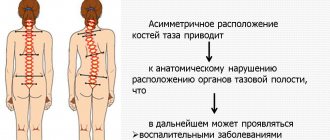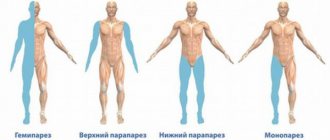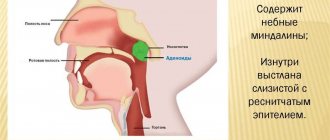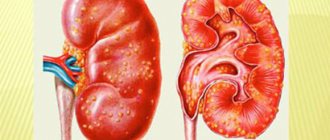Causes of obesity in children
- Gestational diabetes is diabetes acquired by the mother during pregnancy.
- Artificial or short (up to 6 months) breastfeeding.
- Consumption of high-calorie foods, high sugar, salt and fat content in the diet.
- Wrong eating habits.
- Insufficient physical activity, sedentary lifestyle.
Less common factors that increase the risk of the disease: hypothyroidism and other endocrine dysfunctions, genetic and hereditary disorders, lack of sleep and poor daily routine, and taking certain medications. Without correcting the causes, obesity persists into adolescence and adulthood. Most obese adults experienced weight problems during childhood.
Why does a child become overweight?
Depending on the cause, childhood obesity can be:
- primary - due to heredity, congenital pathologies;
- secondary - acquired.
The causes of obesity in children are divided into:
- Endogenous (internal, physiological or medical). This includes 2 types of obesity:
- neurogenic - occurs in the presence of brain tumors or neuroinfections, skull injuries.
- endocrine – for metabolic disorders and diseases of the endocrine system.
- Exogenous (external, social) factors, 95% of cases of the disease occur as a result of prolonged, regular exposure from the outside. This includes nutritional obesity, which is caused by physical inactivity and overeating.
Endogenous factors
Endogenous causes of excess weight problems include:
- Heredity. According to statistics, 85% of overweight parents have children who suffer from excess accumulation of fat mass.
- Chromosomal, genetic syndromes: Down, Alström, Prader-Willi, Cohen, fragile X chromosome, pseudohypoparathyroidism.
- Chronic diseases leading to an imbalance of metabolic processes (pathologies of the thyroid gland, adrenal glands, pituitary gland).
- High birth weight. A risk factor is considered to be a newborn weighing more than 4 kg.
Exogenous
External factors are the most common cause of obesity in childhood. These include:
- Overnutrition – exceeding the daily calorie intake for a long time. Oversaturation with fast carbohydrates, which are found in sweets and flour products, is especially dangerous. They increase the amount of insulin in the blood (hyperinsulinemia), which provokes fat deposition.
- Lack of sleep, stress - excessive emotional stress can lead to the development of eating disorders.
- Physical inactivity is a complete absence or insufficient physical activity. Children eat a lot of calories that require active movement to burn, but instead they spend most of the day on the phone or in front of the computer.
Obesity levels
Diagnosis is made based on body mass index. This is a calculated value - weight divided by the square of height:
BMI = weight (kg)/height2 (m)
The resulting value is assessed taking into account age and gender.
Table 1. Obesity in boys based on BMI
| Age | Normal weight | Excess weight | Obesity |
| 1 | 17,2 | 19,4 | 19,9 |
| 2 | 16,5 | 18,4 | 19 |
| 3 | 16 | 17,8 | 18,4 |
| 4 | 15,8 | 17,5 | 18,1 |
| 5 | 15,5 | 17,3 | 18 |
| 6 | 15,4 | 17,4 | 18,1 |
| 7 | 15,5 | 17,7 | 18,9 |
| 8 | 16,4 | 19,3 | 22,6 |
| 9 | 17,1 | 19,4 | 21,6 |
| 10 | 17,1 | 21,4 | 25 |
| 11 | 17,8 | 21,2 | 23,1 |
| 12 | 18,4 | 22 | 24,8 |
| 13 | 19,1 | 21,7 | 24,5 |
| 14 | 19,8 | 22,6 | 25,7 |
| 15 | 20,2 | 23,1 | 25,9 |
| 16 | 21 | 23,7 | 26 |
| 17 | 21,6 | 2,7 | 25,8 |
Table 2. Obesity in girls based on BMI
| Age | Normal weight | Excess weight | Obesity |
| 1 | 16,6 | 18,6 | 19,3 |
| 2 | 16 | 18 | 18,7 |
| 3 | 15,6 | 17,6 | 18,3 |
| 4 | 15,4 | 17,5 | 18,2 |
| 5 | 15,3 | 17,5 | 18,3 |
| 6 | 15,3 | 17,7 | 18,8 |
| 7 | 15,5 | 18,5 | 19,7 |
| 8 | 15,9 | 18,8 | 22,3 |
| 9 | 16,4 | 19,8 | 23,4 |
| 10 | 16,9 | 20,7 | 23,4 |
| 11 | 17,7 | 20,8 | 22,9 |
| 12 | 18,4 | 21,5 | 23,4 |
| 13 | 18,9 | 22,1 | 24,4 |
| 14 | 19,4 | 23,2 | 26 |
| 15 | 20,2 | 23,2 | 27,6 |
| 16 | 20,3 | 22,8 | 24,2 |
| 17 | 20,5 | 23,4 | 25,7 |
The degree of obesity is determined by the deviation of BMI from the norm:
- 1st – 15-24%;
- 2nd – 25-49;
- 3rd – 50-99%;
- 4th – 100% and more Source: O.V. Vasyukova Obesity in children and adolescents: diagnostic criteria // Obesity and Metabolism, 2020, No. 16(1), pp. 70-73
Children in their first year of life are not diagnosed with obesity. Excess weight in a child during this period is called paratrophy. Paratrophy:
- 1st degree – weight is 10-15% higher than normal;
- 2nd degree – by 15-30%;
- 3rd – by 30% or more.
Table 3. Infants up to one year old. Average weight and height
| Age, months | Norm of weight gain for boys, grams | Norm of weight gain for girls, grams |
| 1 | 400-1 200 | 400-900 |
| 2 | 400-1 500 | 400-1 300 |
| 3 | 600-1300 | 500-1 200 |
| 4 | 400-1 300 | 500-1 100 |
| 5 | 400-1 200 | 300-1 000 |
| 6 | 400-1 000 | 300-1 000 |
| 7 | 200-1 000 | 200-800 |
| 8 | 200-800 | 200-800 |
| 9 | 200-800 | 100-600 |
| 10 | 100-600 | 100-500 |
| 11 | 100-500 | 100-500 |
| 12 | 100-500 | 100-500 |
Obesity classification
The criteria by which it is determined whether children are overweight are different in each country. Doctors have not yet come to a consensus on this matter. In Russia, experts adhere to the criteria developed by researcher A.A. Gaivorskaya.
She identifies 4 degrees of obesity in a child:
- I - weight is 15-24% higher than normal
- II - weight above normal by 25-49%
- III - weight above normal by 50-99%
- IV - weight is 100% or more above normal
80% of overweight children have 1-2 degrees of obesity.
Signs and symptoms
In addition to excess weight and excess body volume, the disease causes:
- Infants have frequent constipation and bloating, excessive sweating, dermatitis and eczema. Possible difficulty breathing, frequent bronchitis and pneumonia.
- Preschoolers and primary schoolchildren have slow physical development and the appearance of fatty folds on the body. The child avoids active games with peers, and during physical activity he develops shortness of breath. Possible snoring during sleep, secondary flat feet and curvature of posture.
- In adolescents (10-19 years old) - disordered eating behavior (gluttony). Hypertension and depression are possible Source: https://www.ncbi.nlm.nih.gov/pubmed/18230896/ Sabin MA, Shield JPH. Childhood obesity // Front Horm Res. 2008;36:85-96. doi: 10.1159/000115356
Diagnosis of the disease
The main indicator when making a diagnosis is the calculation of BMI. Additional research allows us to determine the cause and choose effective treatment tactics. To do this, the doctor:
- conducts interviews and collects family history;
- measures the child's waist circumference and blood pressure;
- prescribes blood tests - biochemical, for the level of thyroid hormones and insulin;
- determines the amount of fat using bioimpedansometry;
- refers the child to an ultrasound of the thyroid gland and abdominal cavity, an ECG, examination by an endocrinologist, gastroenterologist, neurologist and geneticist.
What problems does obesity cause?
Possible complications:
- from the gastrointestinal tract - gastritis, duodenitis, colitis, chronic constipation and hemorrhoids;
- from the cardiovascular system - hypertension, coronary heart disease, atherosclerosis, heart attacks and strokes;
- from the musculoskeletal system - joint degeneration, curvature of the spine, protrusion and hernia of the spinal column, flat feet;
- dysfunction of the endocrine system - impaired insulin resistance and diabetes Source: M.V. Zagoruiko, T.P. Bardymova, L.V. Rychkova Obesity in children and adolescents // Siberian Medical Journal, No. 6, pp. 16-18
In addition, varicose veins of the lower extremities develop, and the risk of developing trophic ulcers, cancer of the colon, mammary glands and uterus increases.
Why children get fat: obesity - causes and statistics
Obesity in children can be caused by a number of reasons.
Factors among and genetics take part in its development. In 100% of cases, the essence of obesity is an energy imbalance, which is caused by decreased energy intake and increased energy consumption. If both parents have obesity, then there is an 80% chance that their son or daughter will have the same disorder. If only the mother is obese, then the child’s chance of having a similar condition is 50%, and if only the father is obese, then 38%.
At risk are children who were born weighing more than 4 kg, as well as those who have monthly weight gain above the norm, and who are bottle-fed. Obesity in infants can occur due to feeding them with high-calorie formulas in excess quantities or due to violations of the rules for introducing complementary foods for infants.
In most children of small and school age, obesity occurs if the diet is disrupted and the child receives little physical activity. Obesity appears if the diet is dominated by “fast” carbohydrates (easily digestible), solid fats (obtained from “fast food”), carbonated water, store-bought juices and teas with sugar. However, obese children usually do not have enough protein, fiber and water in their diet.
An important factor is a sedentary lifestyle. Obesity threatens those who do not play any sports, do not play active games, do not go to physical education classes, or are inactive during them. Also risk factors: intense mental stress leading to physical inactivity, frequent spending time at the computer or on the couch watching TV.
The cause of obesity (excess weight) in children can be serious pathological conditions:
- Prader-Wili syndrome
- Down syndrome
- Cohen's syndrome
- Lawrence-Moon-Biedl syndrome
- Itsenko-Cushing syndrome
- congenital hypothyroidism
- adipose-genital dystrophy
- meningitis, encephalitis
- traumatic brain injury
- brain tumors
- neurosurgical intervention
Sometimes obesity can be triggered by the following emotional reasons:
- accident
- entering the first grade of school
- death of relatives
- a child witnessed a murder or other crime
A chronic metabolic disorder, in which a child’s body weight rapidly increases, exceeding fifteen percent above normal, is called obesity. It has been included in the International Classification of Diseases (ICD) since 1989.
In children, it occurs very quickly and is characterized by the development of cholecystitis, frequent constipation, early arterial hypertension (increased blood pressure), arthrosis, and apnea. Health problems can grow like a snowball. There may be diabetes, flat feet or even gonadal dysfunction in the future. Therefore, you need to fight excess kilograms as soon as the problem becomes obvious.
Some numbers
The statistics on childhood obesity are staggering. Such numbers are thought-provoking and make us think about future generations.
- More than 12.5% of the total number of Russian teenagers and children are overweight.
- In urban settlements, 8.6% of children are obese.
- Among the rural population, the numbers are slightly lower – only 5.4%.
Pediatric endocrinologists and nutritionists are sounding the alarm - these statistics really look ominous. For sixty percent of adults, problems with weight gain begin in childhood or adolescence. As a result, the musculoskeletal system suffers, problems with the gastrointestinal tract, secretions, and cardiovascular system appear.
Childhood obesity hides its polyetiological nature. The cause of such problems is a complex of problems of genetic predisposition, as well as environmental conditions. In any case, a serious difference in the amount of energy received and expended becomes a fundamental factor that causes extra pounds to accumulate in the form of fat. But it’s not just nutrition that’s to blame.
- In dense, obese parents, children suffer from the same disease in eighty percent of cases. The risk is reduced if only the mother suffers from excess weight up to fifty percent, and if the father, then up to thirty-seven percent.
- With incorrectly formed eating habits in a family where children are growing up, the problem of excess weight will most likely appear. Eating “fast” carbohydrates, fast food, fried fatty foods.
- A sedentary lifestyle, instilled from infancy, can also subsequently lead to a set of extra pounds, and as a result, to health problems.
- Babies born with increased weight (more than four kilograms) are also at risk of being overweight.
- Obesity can be caused by objective pathologies (Cohen, Prader-Wili, Down syndromes), lesions of the central nervous system (cerebral palsy, meningitis, brain tumors), endocrinopathies (adiposogenital dystrophy, Itsenko-Cushing syndrome, hypothyroidism).
There are also hidden psychological reasons that no analysis can reveal. You won’t be able to do this without a specialist. However, it is possible to trace the beginning of weight gain and identify a connection with stressful events in life - entering kindergarten, school, death or illness of relatives, and other severe shocks.
Treatment: clinical recommendations
The main type of treatment for obesity is correction of nutrition and drinking regime. Includes changing the regimen - the child is fed 5-6 times a day, the doctor calculates the daily water consumption individually. With each dose - towards the evening - the calorie content of the serving is reduced. The child should eat the main part of the diet in the first half of the day, the last meal should be 2-3 hours before bedtime. It is important to control the pace of eating - it should be slow.
In the structure of the diet, it is necessary to limit the consumption of carbohydrates at the expense of quickly digestible ones. Fast food, industrial semi-finished products, confectionery and sweet soda are excluded from the menu. The amount of fat is reduced due to refractory ones of animal origin. The child should receive sufficient amounts of protein, complex carbohydrates and vegetable fats, vitamins and minerals. Unbalanced diets, a sharp reduction in salt and other “adult” diets for children are dangerous and unacceptable. An individual menu is developed by the attending nutritionist.
In addition, regular feasible physical activity is required - at least 1 hour a day. It is extremely important that family members also normalize their eating behavior and lifestyle.
In severe cases - if physiological disorders are identified - drug therapy may be prescribed. It is carried out strictly under the supervision of a doctor. Self-medication is strictly prohibited.
Treatment
In terms of treatment for children with overweight or obesity, the main directions have remained unchanged:
- lifestyle change
- pharmacotherapy
- surgical intervention
As noted above, the main tenet of treatment for overweight or obesity is lifestyle modification with changes in dietary and behavioral habits.
In cases where just normalizing lifestyle is not enough, pharmacological drugs are used to treat obesity, but it should be borne in mind that many drugs are not approved for use before reaching the age of 16, with the exception of one - metformin.
However, if the doctor is convinced that behavioral measures are not working, he may use pharmacotherapy if he has sufficient experience with these drugs or if the therapy is being conducted as part of a clinical trial. In recent years, the role of the intestinal microbiome in the genesis of obesity has been shown; It is proposed to use microbiota correction methods to treat obesity.
As for the use of bariatric surgery in the treatment of obese children, the latest recommendations impose strict patient selection criteria and allow the use of this treatment method only in extreme cases.
The criteria for the admissibility of bariatric therapy in pediatric practice are:
- the patient’s sexual development corresponds to Tanner 4 or 5, closure of growth plates, weight criterion - BMI >40 kg/m2 or BMI >35 kg/m2 with significant concomitant diseases;
- the presence of extreme obesity despite pharmacotherapy or after lifestyle changes;
- favorable psycho-emotional status of the family and patient;
- favorable behavioral and psychological prognosis for the recovery period after bariatric therapy.
Experts emphasize that the patient and family members must be highly motivated to lose weight and have a strong understanding of the long-term restrictions associated with bariatric surgery.
Despite the significant intensification of scientific research in the field of childhood obesity, at this stage additional research is needed in the field of genetic and biological factors that increase the risk of increase.
Prevention in children and adolescents
- Early initiation of breastfeeding - within 1 hour after birth.
- Exclusive breastfeeding for at least the first 6 months.
- Balanced complementary foods.
- In school and adolescence - control the total consumption of fats and sugar. You should increase your intake of protein, whole grains, legumes, vegetables and fruits.
- Regular physical activity of at least 1 hour per day.
- Maintaining healthy eating habits in the family. Source: A.A. Kamalova Modern approaches to the prevention of obesity in children // Russian Bulletin of Perinatology and Pediatrics, 2020, No. 6, pp. 43-47.
To avoid irreparable harm to the health of a child with signs of obesity, consult a specialist in a timely manner.
Sources:
- O.V. Vasyukova. Obesity in children and adolescents: criteria for diagnosis // Obesity and Metabolism, 2020, No. 16(1), pp. 70-73.
- https://www.ncbi.nlm.nih.gov/pubmed/18230896 Sabin MA, Shield JPH. Childhood obesity // Front Horm Res. 2008;36:85-96. doi: 10.1159/000115356.
- M.V. Zagoruiko, T.P. Bardymova, L.V. Rychkova. Obesity in children and adolescents // Siberian Medical Journal, No. 6, pp. 16-18.
- A.A. Kamalova. Modern approaches to the prevention of obesity in children // Russian Bulletin of Perinatology and Pediatrics, 2020, No. 6, pp. 43-47.
The information in this article is provided for reference purposes and does not replace advice from a qualified professional. Don't self-medicate! At the first signs of illness, you should consult a doctor.
Danger of disease for a child
Excess weight is not just an aesthetic problem. In addition to bullying by peers, the disease can lead to other consequences. This includes diseases typical of adults. So what are the risks of obesity to a child?
If you ignore the symptoms or reach such a stage that treatment is useless, you can acquire a lot of diseases. Diabetes mellitus, liver dystrophy, cardiac ischemia, hypertension, etc. often develop. Among other things, a person’s life span is shortened, as the body weakens from year to year. The baby's gastrointestinal tract is especially affected. Therefore, diseases such as pancreatitis, cholecystitis and fatty hepatosis are more often diagnosed in obese children. The heart may also suffer, as there have been cases of atherosclerosis and angina pectoris.
But the most serious load falls on the skeleton, joints and cartilage. Every minute they have to bear excess weight. Under such a mass, deformation of organs is inevitable, which leads to a change in proportions and severe pain.











